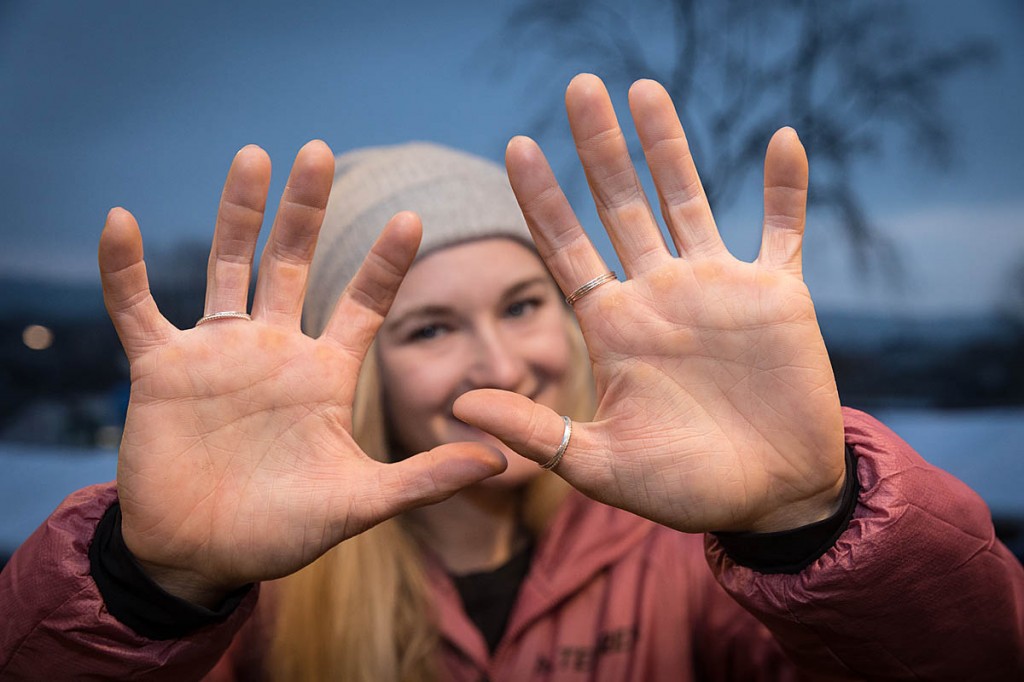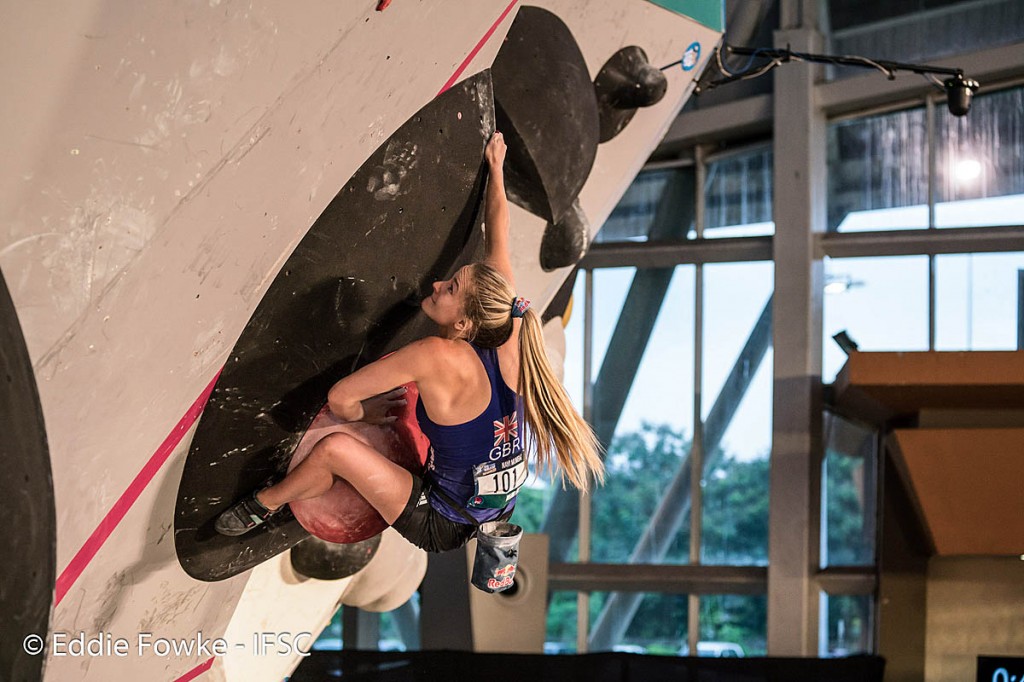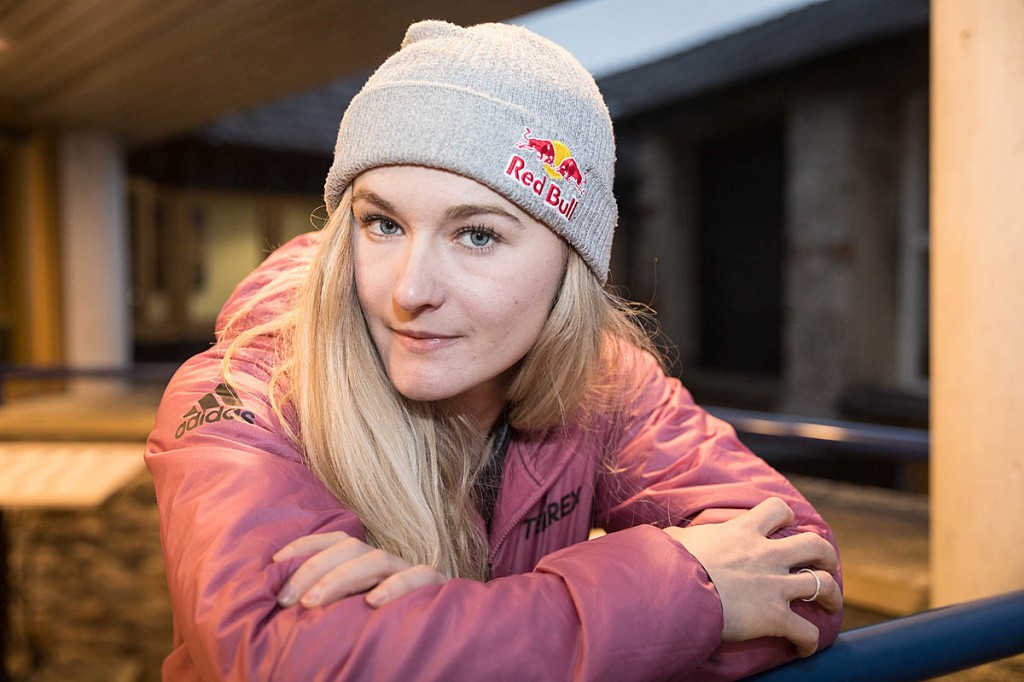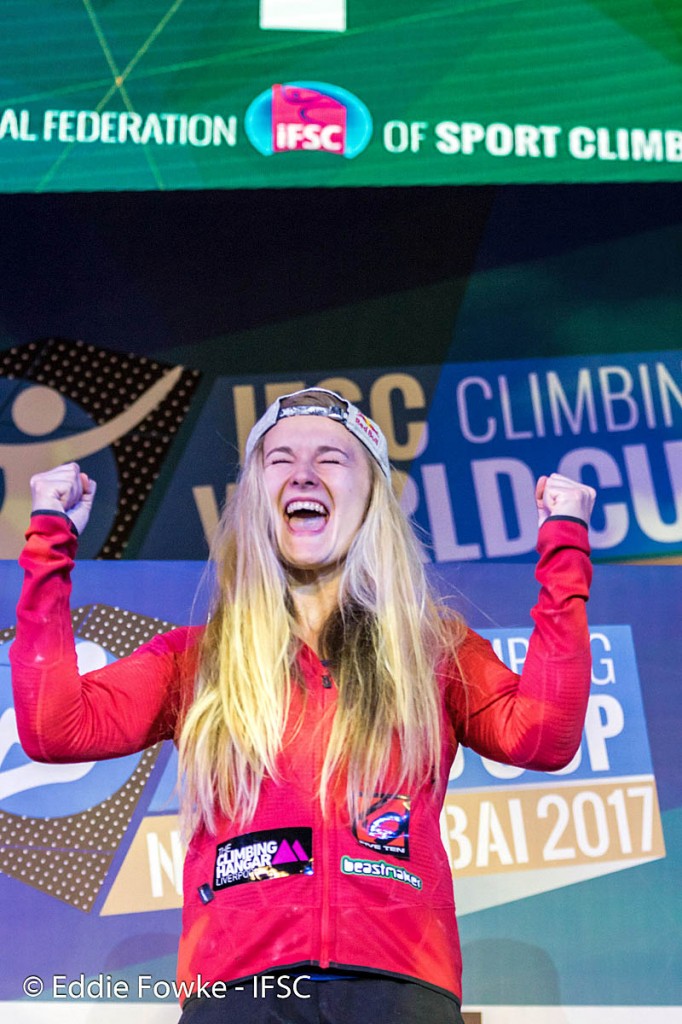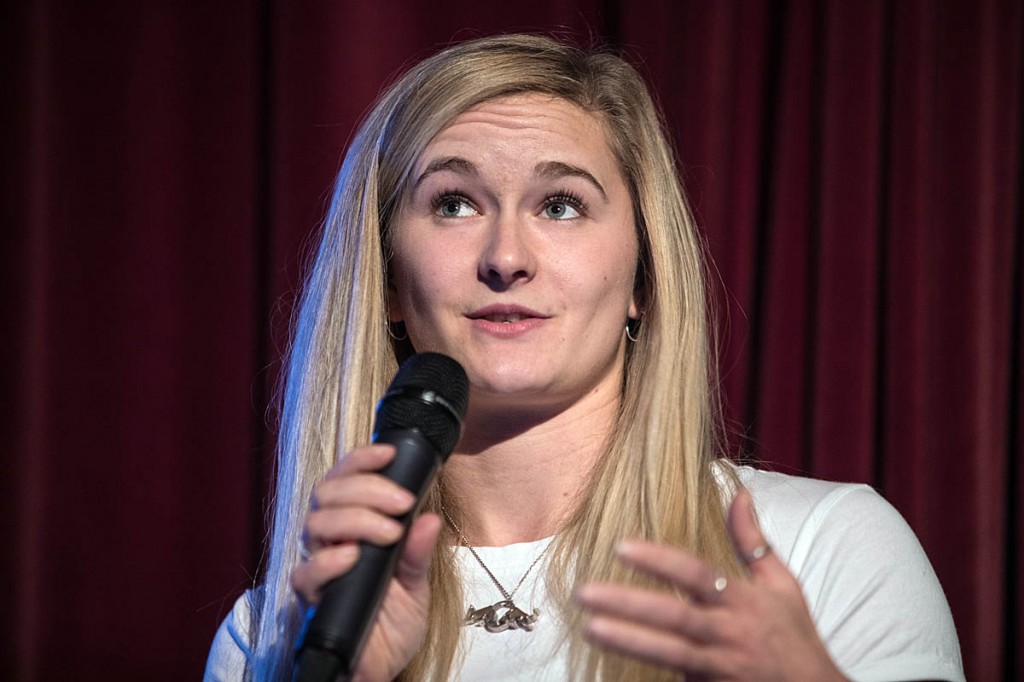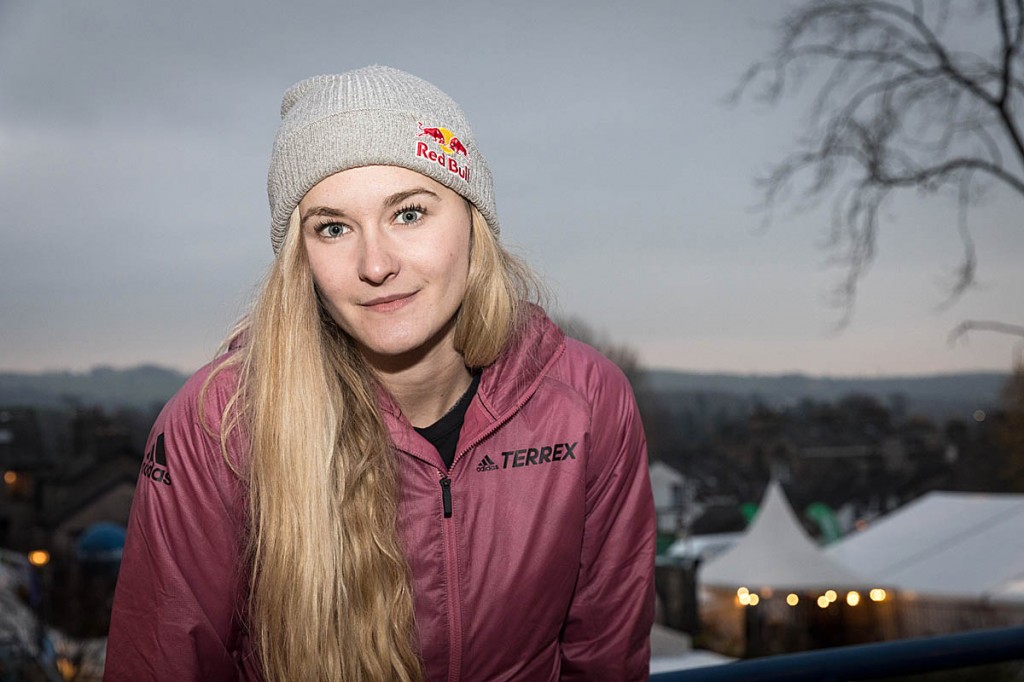In a little more than 18 months, the profile of climbing will gain a massive boost when millions of television’s worldwide audience will be able to view top proponents of the sport fight for Olympic medals.
But the climbing that will form part of the 2020 Tokyo Olympics is a far cry from most lay people’s idea of the activity.
There will be no weather-lashed mountaineers grappling with problems on gritstone or hand-jamming a crack in a limestone crag.
Instead, Olympic climbing will take place on artificial walls designed to test the technical ability, strength and mental fortitude of competitors.
One of Britain’s brightest stars in the world of competition climbing is Shauna Coxsey, who has twice won bouldering’s world cup championships.
Bouldering is one of three disciplines Olympic climbers will have to excel in if they are to be in the medals.
We caught up with the 25-year-old Sheffield-based athlete at last month’s Kendal Mountain Festival where she held the audience’s attention with the tale of her route to the top of the climbing ranks. The session was hosted by climbing-wall equipment firm Entre-Prises, one of Coxsey’s sponsors, who have enabled the climber to devote herself full-time to the sport.
She explained the three types of competition climbing that will form the Tokyo event.
“In the Olympics, bouldering is my preferred discipline; it’s the one I do the best; I’ve competed in it for a number of years as an elite adult. It’s climbing not too high off the ground, up to about 4m. It’s above mats, so there are no ropes involved and varying angles and varying styles of climbing.
“You’ve then got lead climbing which I’m also familiar with; I competed a lot as a junior in lead climbing. That’s roped climbing; you climb up with a rope tied to your harness and clip it in as you go. There are much longer routes, so a bit more endurance-based, battle over the forearm pump; often not as difficult moves as in the bouldering but really still tricky and hard.
“And then you’ve got speed climbing which is very new to me. It’s how fast can you get up that wall and it has been the same climb for a number of years now. So you need to learn that climb and know it inside out and really execute, which is something that, in climbing competitions I’m not familiar with at all because we climb on things we’ve never seen before. Speed climbing is this learnt route.”
This year has been a fallow year for the Runcorn-born climber after an injury put her out of competitions.
“The injury that kept me out of the world cup was a partial – 80, 90 per cent tear – of my A2 pulley, which is a tiny little tendon in my finger.
“Most people wouldn’t even realise it was there, let alone if they hurt it, but the reality is, a climber is a little bit different in the sense that it massively impacts your sport. Your fingers are the contact with the wall. It has been a long journey to come back from this one and it’s so hard because people are saying: ‘can I see it’ and there’s absolutely nothing to show for it. I wish a scar or a bruise even, but there’s nothing there. It has been a battle to come back from.
“I’m so close. I want to say pretty much there, but my physios wouldn’t be happy about that because they are the ones who are restricting me at the minute, to hold me back to make sure we fully rehab it and there’s no ongoing injury there. Right now, I’m just being held back a little bit for precautions because we have the time and the space to do that and my training demands are so intense right now that we don’t want to overdo it with the fingers.
“I’m close, and I’m really excited to be back on the wall.”
Her route to climbing stardom began 22 years ago when she saw a documentary about top French climber Catherine Destivelle on television.
“I was three years old when I first watched the programme and I was four when I started climbing.
“I didn’t know that she did a lot of bouldering until quite recently. I was inspired by seeing her free climbing and soloing on the cliffs in Mali. That’s initially what inspired me to try the sport and it made me want to go climbing.
“I’ve thought a lot about it and I can’t quite decide if I do remember that moment of being sat on my dad’s knee or whether it’s something I’ve talked about so much and relived so many times that it’s kind of a response.
“I remember my early days of being on the wall and just being massively in love with it and just saying to my family: ‘I really enjoy this’ and saying: ‘I want to go again, I want to go again’. And they’re thinking, OK, when are you going to get bored of this? Over 20 years I’m still waiting for me to get bored of it so I don’t think that’s going to happen.”
Coxsey said climbing is open to anyone, but if you want to excel, it takes a lot of training.
“I think as a beginner climber, one thing I say a lot is: if you can climb up the stairs, then you can climb a climbing wall. You don’t need to be physically strong; you don’t need to be able to do pull-ups to go climbing. If you want to be an elite climber, however, you need to be able to walk up the stairs on the tiniest little things you’ve ever seen and then do loads of pull-ups and then jump around a lot. At the elite level, it’s a little bit different.
“As a beginner, it’s all about your legs and using them. Your legs are much bigger than your arms; they are so much stronger and if you can learn to climb well initially, you’ll climb a lot better in the future.
“It depends how you want to go climbing really; if you want to go climbing with your arms and thug your way around things, it’s a different story.
“In bouldering, your legs are 100 per cent as important as your arms. In a bouldering world cup, you need to be equally as strong in your legs as your arms – and your head.”
Coxsey made the move across the Pennines from her home county of Cheshire to South Yorkshire, which gives her easy access to the Peak District crags.
“I swore I would never move to Sheffield because it is the cliché place to move as a British climber but that didn’t happen.
“I love living in Sheffield, being in the outdoor city. It’s such a great place to immerse yourself in the outdoors but with the good bits of having a city so close as well. So I’m glad I did make the move. I had a bet with my dad I would never move there, and I’ve lost that bet.
“All my family are still in Cheshire. I’m like the black sheep that moved to the other side of the Pennines. It means they get to come and visit and have weekends in the Peak, so they don’t complain.”
She now has her sights firmly on the Tokyo games and putting her injury behind her. “I’m training for the Olympics right now. My goal is to qualify for the Olympics and then go on to compete to win a medal there.
“My team around me is really strong and I feel incredibly lucky to have such an amazing team and that really motivates me to push myself.
“I’m the type of person who need goals that I’m working towards and having the Olympics is kind of a dream. I never expected climbing to be part of the Olympic games so to be here now is a little surreal but I’m absolutely loving the process.
“When you can’t do full training, I can’t not train; I can’t not be busy. There are always things to train. Injury just gives you a new perspective and allows you to work on other weaknesses, so I almost don’t feel at a disadvantage in a way because I’m in the gym, I’m working really hard and I’m really conditioning myself to handle that training when it comes to the point where I’m able to do everything on the wall again, so it’s an exciting time.”
There’s no guarantee she will make the Olympics, even with her record of bouldering championships. Coxsey will have to join other would-be Tokyo climbers in selection competitions next year.
“The first selection event will be in Tokyo in August 2019 where six athletes will be selected, six men; six women. And then a further six will be selected in Toulouse, which is likely to be at the end of the year. It’s not a British selection; it’s international. There are 20 athletes worldwide who will be selected for the event, 20 men; 20 women.
“You have to qualify for the event through the British team by whatever means necessary and then anyone who enters that world championship in Tokyo next year, at the selection event, could qualify.”
Pressed on which mountaineering luminaries or climbers have inspired her recently, she said her motivation comes from closer to home.
“I take my inspiration really from the people around me. I feel really lucky to come from a family that’s incredibly supportive and incredibly ambitious and I also am inspired by what I see daily, by going to the climbing wall and I see a total beginner pushing themselves to get to the top of that first ever climb that they’ve done. I look at that and I think: I am not trying hard enough.
“That is so inspiring to me. Yes, the cutting edge and the elite is inspiring, but it’s aspirational as opposed to inspirational. My other half trains harder than anyone I’ve ever met and I feel very lucky to live with someone who pushes themselves so much and achieves such big goals. I feel incredible fortunate to have a really good team of people around me.”
Climbing and other outdoor sports receive much less publicity than mainstream athletics and sports, yet its elite proponents are at least equal to more familiar sports superstars. Does this irk her?
“When I started climbing, the sport was so much smaller than it is now. I never thought I’d be doing this many interviews and have a stage to promote the sport that I do now, so in a way I don’t find it annoying because we’re on this journey and becoming bigger and bigger and getting more publicity.
“You could step back and say: that’s really annoying or you could step in and do something about it and help promote the sport. I think climbing is one of the best sports people can do. It’s one of the lease monotonous sports. You can always do something different; there are always new climbs to try.
“It’s a lot different from going to the gym and I want to put it on the biggest stage possible so more people try it and more people therefore lead a healthier lifestyle. I love climbing so I want to promote it in the best possible light so it’s a really exciting time for our sport right now.”
What goes through her mind when she prepares to climb?
“I stand at the bottom of a climb and I think it’s always different because I look at a climb and I don’t process what I’m going to do; it’s almost subconscious.
“The only time I’m thinking is if I don’t know what I’m going to do and I have a few different options but then again it’s more reactive than planned out. It depends where I am; what I’m doing. If I’m standing on the stage in front of 9,000 people I’ve got to do that climb to win a world cup, what’s going through my mind before I step in front of the climb is different from that moment when I pull on a wall because it’s a very different experience.”
Shauna Coxsey has risen a long way since she was first captivated by watching Destivelle’s televised adventures. If she makes the grade for Tokyo 2020, who knows, she could be the inspiration for another three-year-old sitting on a parent’s knee enthralled enough to want to step into her climbing shoes.
